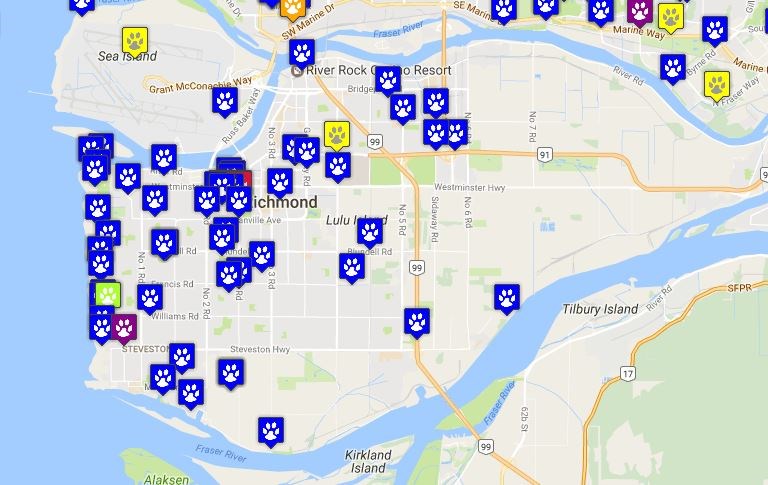Steveston resident and dog walker Isabel Huenefeld is taking extra caution these days while walking her furry clients in and around the village, as well as other popular pooch destinations in Richmond.
That’s because she and other dog walkers have become aware of a pack of coyotes in south Richmond that may be becoming more aggressive toward pets and humans as the winter food supply runs short.
Furthermore, there are accounts, says Huenefeld, of people feeding the coyotes, which is illegal under the B.C. Wildlife Act, as coyotes are considered a dangerous animal.
Coyote sightings in human populated areas can be reported to the Ministry of Environment (1-877-952-7277), as well as the Stanley Park Ecology Society (604-681-9453), which documents coyote sightings, as well as their behaviour, in the Lower Mainland.
At the south dyke at No. 3 Road, where there is an off-leash area for dogs, coyote sightings became so frequent last year that the City of Richmond posted a warning sign for pet owners to keep their dogs closely supervised. On June 10, one coyote was seen approaching people and dogs in the park, according to the society’s online coyote sighting map.
The pack of four coyotes in the farmland area of south Richmond was last spotted and documented on Oct. 16, between Gilbert and No. 2 roads.

The society documented at least one account of a person leaving meat out for a coyote on the West Dyke Trail, near Williams Road, in late November.
One of the most concentrated areas for coyote sightings in the past year is Brighouse elementary school, where school officials have had to keep a watchful eye; on May 19, a coyote growled at a person on Azure Road.
Another popular area is the West Dyke Trail, which is the coyote’s natural habitat (east of the dyke is an official wildlife management area) as it’s heavily populated with small mammals as a food source. Quilchena golf course also provides a popular pasture for the animals.
According to the society, there are no places a coyote cannot be spotted in Richmond. Even City Centre has had a few documented sightings this year, as coyotes wander through the Richmond Nature Park and then the Garden City Lands.
The society’s Co-Existing with Coyotes program has some helpful tips for those unfamiliar with the animal: If you encounter one, be “big, brave and loud” to scare it away; never feed a coyote as it will become accustomed to human contact and be more bold in its actions, resulting in its likely destruction; keep your pets on a leash; report sightings.
The society notes that coyotes are typically timid animals and do not want human interaction. Dogs and cats make up about two per cent of their diets. An attack on a human is extremely rare.
Coyotes can often be mistaken for dogs and appear much like a miniature wolf.
Note their fluffy tail, pointed down, their large golden eyes and typical size (shoulder height of 45 centimetres and average weight of 14 kilograms). They can sprint fast (65 km/h) and jump as high as five metres.
The society provides schools with education sessions on the animals.



